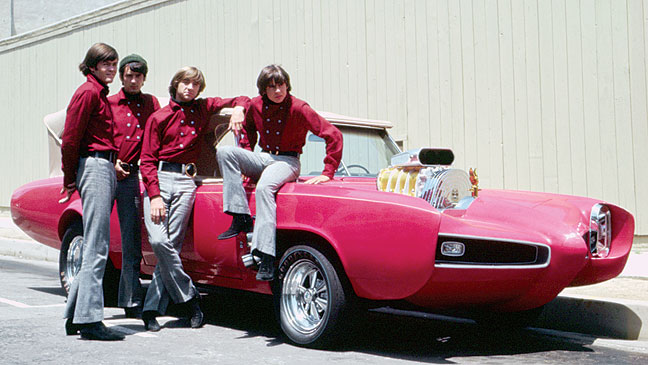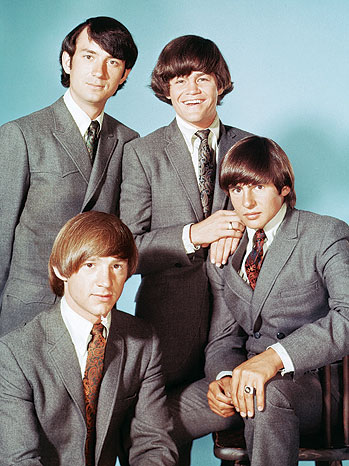How Davy Jones and the Monkees Impacted Music, Hollywood — and Jack Nicholson
 With the death of the legendary frontman, the band’s former manager reveals the impact of the “Prefab Four.”
With the death of the legendary frontman, the band’s former manager reveals the impact of the “Prefab Four.”
Davy Jones, who died Feb. 29 of a heart attack at 66, was the focal point of The Monkees, but he was far more than teen magazine eye candy — much like the made-for-TV group that launched his career wasn’t a mere flash in the pan. The foursome, which also included Micky Dolenz, Peter Tork and Michael Nesmith, pioneered the music video format and paved the way for every boy band that followed in their wake, from New Kids on the Block to ‘N Sync to Jonas Brothers, while Davy set the stage for future teen idols David Cassidy and Justin Bieber. As pop stars go, you would be hard pressed to find a successful artist who didn’t take a page from The Monkees’ playbook, even generations later.
In 1965, 37 years before American Idol, producers Bob Rafelson and Bert Schneider put an ad in The Hollywood Reporter, auditioned 437 L.A. hipsters and made overnight idols of Davy, Micky, Mike and Peter. Between 1966 and 1968, they filmed 58 episodes of The Monkees, a comedy about a struggling rock band that combined Beatle-like sounds with Marx Brothers-style humor. The NBC show won two Emmys and spawned nine albums — the first four topped the Billboard 200 — and six Top 10 singles, including “Daydream Believer,” the No. 1 hit sung by Davy, which went on to become his signature tune. During 1967, The Monkees sold more records than The Beatles and The Rolling Stones. All told, the band would move 50 million albums, and since his death, the catalog is selling yet again, with Monkees albums on Amazon’s best-seller list (and Davy’s estate due for an influx of royalties).
But The Monkees’ body of work extended beyond commercial properties: Their psychedelic 1968 cult film Head was produced and co-written by then-unknown Jack Nicholson. Monkee money also enabled Rafelson and Schneider to finance Easy Rider and Five Easy Pieces, which made Nicholson a star. In fact, the Monkees series was the opening salvo in a revolution that brought on the New Hollywood cinema, an influence rarely acknowledged but no less impactful.
PHOTOS: Hollywood’s Notable Deaths of 2012
The group would get its proper due, in a roundabout way, in 1986, when MTV — the prototype for which had been dreamed up by Mike when channel creators bought and aired a 1979 music video clip series he created — launched a Monkees marathon and created a new generation of fans. Three U.S. tours followed, during which Davy, Micky and Peter played for 1.5 million people. The consummate showman, Davy was at the helm of the show’s set list and staging.
Touring was Davy’s favored and most consistent work. He considered his band and fans his family (a father of four, Davy was twice divorced and married a third time in 2009). In 2011, he reunited with Micky and Peter (Mike occasionally performed with the group in 1986, ’89 and ’97) for 47 concert dates including sellouts in London and New York. The tour grossed nearly $4 million. It was an interesting summer for them — and me.
I first met Davy in 1987 when I interviewed him as a 15-year-old fanzine editor. I went on to produce Monkees box sets for Rhino Entertainment and eventually became their manager. I spent three years cajoling them to look beyond their recent differences (which included putting aside solo projects to fully commit to The Monkees) and reunite for what would be their final tour with Davy. The same guys who entranced me at 5 were nearing 70, and I knew they had a greatness that needed to be shared again. Their mixed feelings on the music business and their long and winding relationship weighed heavily, but once they hit the stage in Liverpool on May 12, 2011, the old magic was apparent.
VIDEO: 5 Iconic Monkees Moments
For the next three months we lived in buses and hotels, bringing the music and memories to fans in the band’s grandest stage show in decades. Images from their series and films flashed on a huge screen behind them (just as they had when The Monkees pioneered rear-screen projection for concerts); even Rolling Stone, whose owner, Jann Wenner, has vowed to keep them out of the Rock and Roll Hall of Fame, gushed. On the eve of their London show, I sat with Davy at the Royal Garden Hotel — a place where fans had besieged the band in 1967 — as he reflected on his morning ritual: an extensive walk around town.
“I’ve been thinking this morning about The Monkees,” he said, “how it just keeps going and going. It’s almost biblical, like loaves and fishes.” As the wheels turned in his head, he explored the infinite nature of this initially ephemeral creation. The Monkees started as a show about a group; the group became a band and truly became family. The show went on into endless repeats, the music was preserved and passed on, and the multitudes shared in the love, fun and humor. Yet it had not been an easy road to the present.
Before his life as a Monkee, the 5-foot-3 Davy, who grew up in Manchester, England, had started humbly as an apprentice jockey. At the suggestion of his horse-training hero, Basil Foster, he took up acting, starring in a Tony-nominated role as the Artful Dodger in Oliver! on Broadway. It was during this stint that he appeared on The Ed Sullivan Show the night The Beatles made their American debut in February 1964. Davy got a Columbia Pictures contract, the studio plugged him into The Monkees and success was instantaneous.
Ironically, Davy’s winning smile and British charm brought long hair into America’s living rooms without the slightest backlash, but The Monkees felt the squeeze from the emerging rock press, which openly derided the band as a plastic creation — the prefab four, as it were. Their musical output was tightly controlled by Don Kirshner and roundly criticized as prepackaged, largely because studio musicians like Glen Campbell played the instruments on Monkees albums and the band members didn’t write most of their songs — at least not the hits. The backlash hurt the group and caused them to rebel, with Mike leading the charge to take control in the studio.
But what makes The Monkees’ story different from the constructed idols who followed is how, within four months of their 1966 debut with the No. 1 single “Last Train to Clarksville,” they managed to wrest control of their musical fate, create their own songs and masters from scratch. It was an audacious move that left Columbia Pictures in lawsuits with Kirshner and many wondering if they could succeed outside the system. Davy initially sided with Kirshner, but the power came with chart performance: the million-selling No. 1 albums Headquarters and Pisces, Aquarius, Capricorn & Jones, Ltd. and the iconic hits “Pleasant Valley Sunday” (Davy’s favorite Monkees song, which hit No. 3 during 1967’s Summer of Love) and “Daydream Believer.” The singing and the playing on all these recordings was substantially The Monkees.
Davy was never ashamed of his Monkees past or present. “I sign autographs and [write] ‘The Monkees,’ and most fans say, ‘You don’t have to put that. We know who you are,'” he once told me. Even when the group fragmented, Davy felt like he never left the band. In fact, it was his understanding of The Monkees’ legacy and his connection to the fans that made him the favorite.
The Monkees were not The Beatles. But that meant they were touchable; they were more like us — they never stopped being fans themselves.
Andrew Sandoval, a Grammy-nominated producer and engineer, is the author of The Monkees: The Day-by-Day Story of the 60s TV Pop Sensation.
♦♦♦♦♦
WHAT HAPPENED TO THE MONKEYS?: The four pop stars had distinct talents and diverse careers.
- Davy Jones: The seasoned actor doubled as a record producer, championing such new talents as Harry Nilsson and Neil Young.
- Micky Dolenz: A star of NBC’s Circus Boy (1956-58), the 66-year-old L.A. native also starred on Broadway in Elton John’s musical Aida.
- Peter Tork: The group’s best musician, and at 70 its oldest, Tork is based in Connecticut and plays in the band Shoe Suede Blues. He beat cancer in 2009.
- Michael Nesmith: Heir to the Liquid Paper fortune, Nesmith, 69, now runs online events hub Videoranch 3D and was first to comment on Jones’ death.
♦♦♦♦♦

MONKEE WANNABES WHO FLUNKED THE AUDITION: Some of the greatest names in pop music tried and failed to become Monkees – but they did OK anyway.
- Stephen Stills: After auditioning, he recommended Peter Tork for The Monkees and later made music history with Buffalo Springfield and his friends David Crosby, Graham Nash and Neil Young
- Paul Williams: The 5-foot-2 Williams towers as an Oscar- and Grammy-winning and Emmy-nominated composer for Barbra Streisand, The Carpenters and The Muppets.
- Danny Hutton: His Three Dog Night had more hits than the Monkees — 21 made Billboard’s Top 40 from 1969-75 and 11 cracked the Top 10 — and also sold tens of millions of albums.
 Follow us
Follow us Join us
Join us


